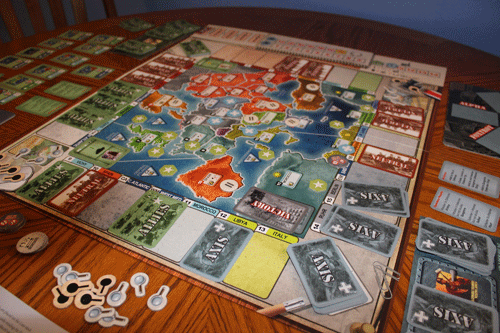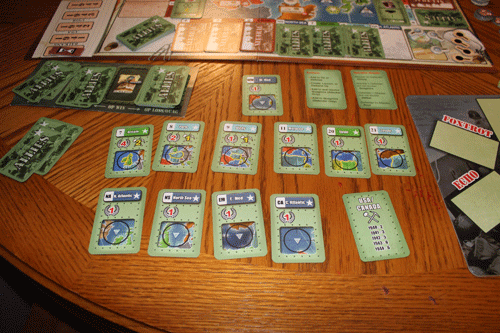The Fog of War Review
on Feb 22, 2017
There’s something visceral and exciting about pushing tons of plastic dudes around on a map. Axis & Allies most famously allowed players to recreate World War II using tiny tanks, planes, army men, artillery pieces, and factories.
The Fog of War retains the spirit of these kinds of games, yet there’s no plastic to be found in the box. See, the trouble with dudes on a map games is that everyone has perfect information. Everyone knows exactly where all your army pieces are, so if you’re trying to plan that cunning, backstabbing maneuver you have to do so with every other player’s eyes watching your every move.

In The Fog of War, your troops are abstractly represented by a simple number on a card—a number which your opponent does not get to see unless he attacks the territory your tanks, armies, or ships are defending. Is the full might of the Allied army defending Paris, or are they all dummies? There’s only one way to find out.
Well, there are actually two ways to find out, as the game offers players a simple, clean system of intelligence. By spending their Intel tokens, players can peek at a randomized subset of any stack of cards in the game, without tipping off the other player as to what cards they actually saw. So you might send spies to check out an offensive the other player has been building up for a few turns and see nothing but dummy cards—but he won’t know that. He may think that his plan to raid Berlin with a massive force has been all but blown.
This kind of spy vs. spy maneuvering makes up the heart of The Fog of War, while clever board play is a close second.
But the most brilliant part of this design is the operations wheel, a simple board that lets players track operations that are still in the planning stages, all the way up until the time comes to put them into motion. Planning an operation for a long time yields attack bonuses but may give the opponent more chances to spy on the troops amassing behind your frontlines, while firing it off early may give you the element of surprise but less chances to scope out the enemy’s defenses and add to your forces.
And so the game goes, with both players taking turns planning operations, reinforcing held territories, and sending spies to figure out where the enemy is going to hit next. It’s a very enjoyable ebb and flow, consisting of major, concentrated offensives that are exciting to play out on the table.
As in any World War II strategic-level game worth its salt, The Fog of War usually begins with the Axis making major territory grabs, with the ability to nearly wipe out the Allies in the opening years of the game. But eventually, the Allies begin to get their war machine rolling, with the U.S.S.R. entering the fray partway through to lend its armies and resources to the fight. The U.S. contributes more and more resources as the game goes on, until the final year sees the Allies outmatching the Axis on all fronts.
The job of the Axis player, then, is to garner as many victory points as possibly early on, or else hold on to two key territories that were secretly chosen at the beginning of the game.

This means the flow of the game is acceptably historic, while also being really interesting for both sides to play out. Both players get the chance to be on the offensive, and both players get the harrowing experience of seeing their holdings decimated to almost nothing at different points in the course of the game.
The game’s quagmire rules are slightly more complex than the rest of the game, as players must continue resolving the outcome of a battle each turn while both feed more troops into the fray in hopes of winning by attrition. These can bog down the game slightly if you end up with lots of quagmires, adding length to a game that already feels about perfect at its two-hour duration. The rules as written are also slightly obtuse, with some key information tucked into sections you wouldn’t expect.
But these are minor complaints for a game that brings so much innovation to the genre. Whether you’re a jaded player of Axis & Allies or more serious World War II wargames, or else a newcomer to the genre, I’d highly recommend The Fog of War. It’s a knock-down, drag-out fight in which both players are blindfolded—and it’s a real joy.

 Customer Support
Customer Support  Subscribe
Subscribe 




 Account
Account  Wishlist
Wishlist 
